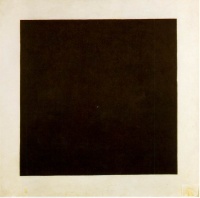Russian art
From The Art and Popular Culture Encyclopedia
![In the Wild North[1] (1891) is a painting by Ivan Shishkin, in the collection of the Kiev Museum of Russian Art.](/images/thumb/200px-Shishkin_na_severe_dikom1.jpg)
|
Related e |
|
Featured: |
The Russian Academy of Arts was created in 1757 with the aim of giving Russian artists an international role and status. Notable portrait painters from the Academy include Ivan Argunov, Fyodor Rokotov, Dmitry Levitzky, and Vladimir Borovikovsky.
In the early 19th century, when neoclassicism and romantism flourished, famous academic artists focused on mythological and Biblical themes, like Karl Briullov and Alexander Ivanov.
Contents |
Realist painting
Realism came into dominance in the 19th century. The realists captured Russian identity in landscapes of wide rivers, forests, and birch clearings, as well as vigorous genre scenes and robust portraits of their contemporaries. Other artists focused on social criticism, showing the conditions of the poor and caricaturing authority; critical realism flourished under the reign of Alexander II, with some artists making the circle of human suffering their main theme. Others focused on depicting dramatic moments in Russian history. The Peredvizhniki (wanderers) group of artists broke with Russian Academy and initiated a school of art liberated from Academic restrictions. Leading realists include Ivan Shishkin, Arkhip Kuindzhi, Ivan Kramskoi, Vasily Polenov, Isaac Levitan, Vasily Surikov, Viktor Vasnetsov and Ilya Repin.
By the turn of the 20th century and on, many Russian artists developed their own unique styles, neither realist nor avant-garde. These include Boris Kustodiev, Kuzma Petrov-Vodkin, Mikhail Vrubel and Nicholas Roerich. Many works by the Peredvizhniki group of artists have been highly sought after by collectors in recent years. Russian art auctions during Russian Art Week in London have increased in demand and works have been sold for record breaking prices.
Russian avant-garde
The Russian avant-garde is an umbrella term used to define the large, influential wave of modernist art that flourished in Russia from approximately 1890 to 1930 - although some place its beginning as early as 1850 and its end as late as 1960. The term covers many separate, but inextricably related, art movements that occurred at the time; namely neo-primitivism, suprematism, constructivism, and futurism. Notable artists from this era include El Lissitzky, Kazimir Malevich, Wassily Kandinsky, Vladimir Tatlin, Alexander Rodchenko, and Marc Chagall amongst others. The Russian avant-garde reached its creative and popular height in the period between the Russian Revolution of 1917 and 1932, at which point the ideas of the avant-garde clashed with the newly emerged state-sponsored direction of Socialist Realism.
Soviet Art
During the Russian Revolution a movement was initiated to put all arts to service of the dictatorship of the proletariat. The instrument for this was created just days before the October Revolution, known as Proletkult, an abbreviation for "Proletarskie kulturno-prosvetitelnye organizatsii" (Proletarian Cultural and Enlightenment Organizations). A prominent theorist of this movement was Alexander Bogdanov. Initially Narkompros (ministry of education), which was also in charge of the arts, supported Proletkult. However, the latter sought too much independence from the ruling Communist Party of Bolsheviks, gained negative attitude of Vladimir Lenin, by 1922 declined considerably, and was eventually disbanded in 1932. After Stalin died Soviet Art went into decline as gradually Russians artists became more independent of the state and in the 1980s the government ruled that it could not restrict what Russians artists could paint.
Architecture
Russian architecture was influenced predominantly by the Byzantine architecture until the Fall of Constantinople. Aristotle Fioravanti and other Italian architects introduced Renaissance trends. The reigns of Ivan the Terrible and Boris Godunov saw the development of tent-like churches culminating in Saint Basil's Cathedral, as shown to the right. In the 17th century, the "fiery style" of ornamentation flourished in Moscow and Yaroslavl, gradually paving the way for the Naryshkin baroque of the 1690s.
Matryoshka doll and other handicraft
A Matryoshka doll (Cyrillic матрёшка or матрешка) is a Russian nesting doll. A set of Matryoshka dolls consists of a wooden figure which can be pulled apart to reveal another figure of the same sort inside. It has in turn another figure inside, and so on. The number of nested figures is usually six or more. The shape is mostly cylindrical, rounded at the top for the head and tapered towards the bottom, but little else; the dolls have no hands (except those that are painted). The artistry is in the painting of each doll, which can be extremely elaborate. The theme is usually peasant girls in traditional dress, but can be almost anything, for instance fairy tales or Soviet leaders.
Other forms of Russian handicraft include:
See also


